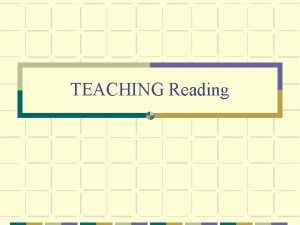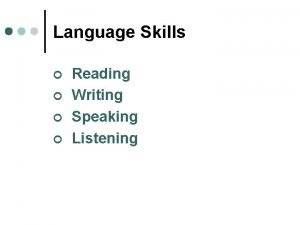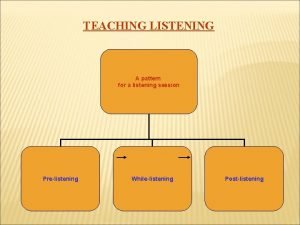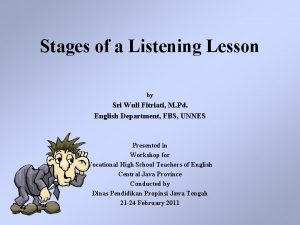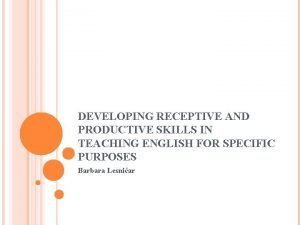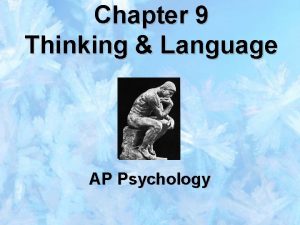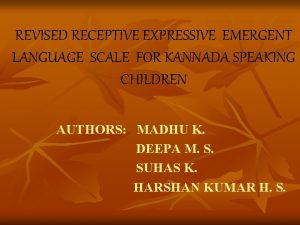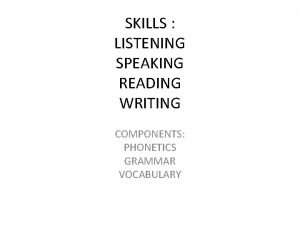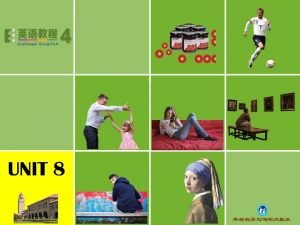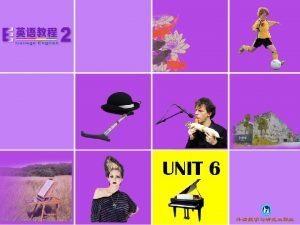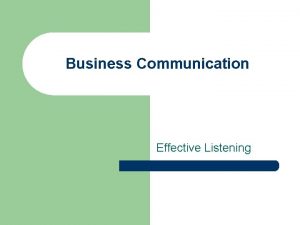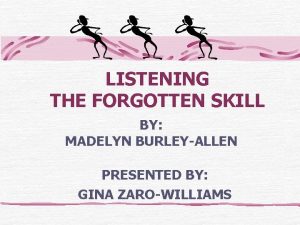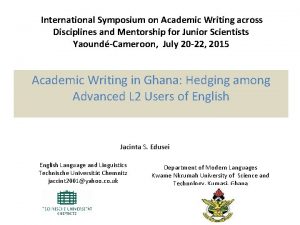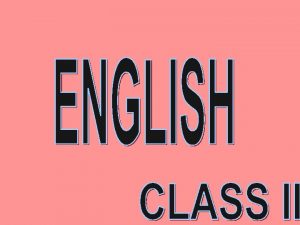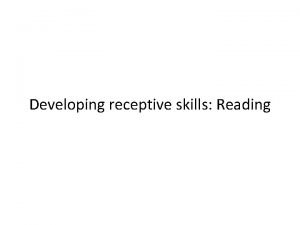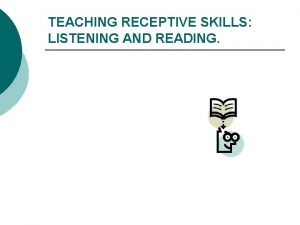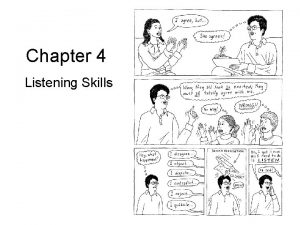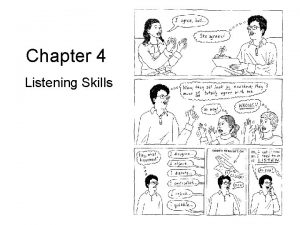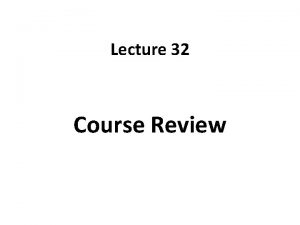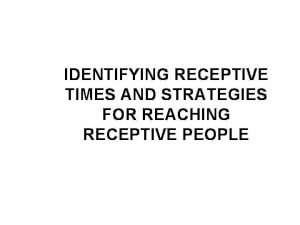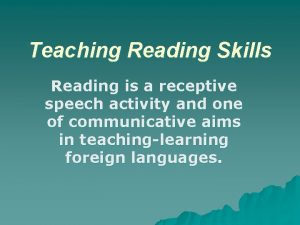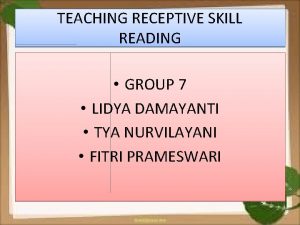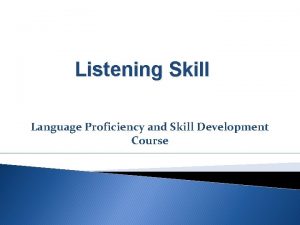ENGLISH WRITING LANGUAGE SKILLS LISTENING RECEPTIVE READING SKILL
























- Slides: 24

ENGLISH WRITING

LANGUAGE SKILLS LISTENING RECEPTIVE READING SKILL WRITING PRODUCTIVE SPEAKING SKILL

WHAT DO WE NEED ?

WHAT DO WE NEED ? VOCABULARY PHRASE SENTENCE

PHRASE PHRASE = A GROUP OF WORDS WITHOUT SUBJECT AND VERB EXAMPLES: Ø THE GRANT PROPOSAL , Ø THE INTERNATIONAL JOURNAL, Ø MY DOCTORAL DISSERTATION, Ø OVERSEAS UNIVERSITIES

SENTENCE = A GROUP OF WORDS WITH SUBJECT AND VERB EXAMPLES : q I MADE THE GRANT PROPOSAL, q THE INT’L JOURNAL IS A COMPULSORY, q SHE IS IN HER THIRD SEMESTER.

SENTENCE SIMPLE COMPOUND COMPLEX

WHAT DO WE NEED ? GRAMMAR KNOWLEDGE WORDS SENTENCE MEANING

EXAMPLE : GRAMMAR KNOWLEDGE INDONESIAN A: MAU KE MANA? B: SAYA MAU POTONG RAMBUT. ENGLISH A: WHERE ARE YOU GOING? B: I WANT TO CUT MY HAIR. B: I WANT TO HAVE MY HAIR CUT.

INTRODUCTION = A MAP v TO GUIDE READERS TO OUR WRITING. v TO WIN READERS’ ATTENTION

PARAGRAPH 1 : GENERAL CONTEXT AND IMPORTANCE THE PROBLEM AREA YOU ARE INVOLVED IN & WHY IS IT IMPORTANT?

PARAGRAPH 2 : SPECIFIC CONTEXT WHAT IS THE SPECIFIC PROBLEM? (NARROW DOWN THE TOPIC AREA OF THE PAPER)

PARAGRAPH 3: KEY PARAGRAPH WHAT ARE THE MAIN CONTRIBUTIONS OF YOUR PAPER. ? WHAT ARE THE GENERAL APPROACH TAKEN? WHY ARE THE SPECIFIC RESULT SIGNIFICANT.

PARAGRAPH 4: DIFFERENTIATION DIFFERENCES IN WHAT YOU ARE DOING AND WHAT OTHERS HAVE DONE. (WHAT IS NEW ABOUT THIS WORK COMPARED TO THE OTHER WORK IN THE AREA.

PARAGRAPH 5: PROVIDE THE READER A ROADMAP FOR THE REST OF THE PAPER THE REMAINDER OF THIS PAPER IS STRUCTURED AS FOLLOWS. . .

WHAT ARE THERE IN A PARAGRAPH MAIN IDEA = A SENTENCE what that paragraph is about (WHAT THE WRITER IS SAYING ABOUT THE TOPIC). The rest of the sentences are details that support the main idea. HOW TO find the main idea, ask yourself, "What is it about? “

POSITION OF MAIN IDEA: AT THE FIRST SENTENCE SUPPORTING SENTENCE

EXAMPLE Summer is a wonderful time to spend at West Beach. It is a beach with light- colored, soft sand. The coastline goes on for a long way and many people enjoy walking along it. Children like to play in the surf and walk along the rocks that are visible at low tide. This is a fun beach for people of all ages.

POSITION OF MAIN IDEA IN THE LAST SENTENCE OF A PARAGRAPH, SO: SUPPORTING SENTENCES MAIN IDEA

EXAMPLE Most teenagers and young adults do not know what they want to do for the rest of their lives. It is a big decision. There a number of things you can do to narrow the choices. For example you can take an interest test, do some research on your own about a career, try volunteer work in the field in which you are interested, or "job-shadow", in which you spend a day with a person who is working in a field that interests you. These are just a few helpful ideas as you begin to choose a career.

WHAT ARE THERE IN A PARAGRAPH THESIS STATEMENT �identifies the main idea and/or central purpose of the text. Also called the controlling idea. (In rhetoric, a claim is similar to a thesis. ) �The thesis statement serves as the organizing principle of the text and usually appears in the introductory paragraph, often at the end

"A strong thesis statement both names the topic and reveals the writer's opinion about that topic. It should be clear and specific. A thesis statement can also list the supporting ideas, but sometimes these are written in a separate sentence. Strong thesis statement: Diwali is an important festival for Indians because they celebrate, remember traditional legends, and enjoy time with their families. The topic is specific enough, and it clearly gives the writer's opinion. In addition, it lists the supporting ideas. " (Dorothy Zemach and Lynn Stafford-Yilmaz, Writers at Work: The Essay. Cambridge University Press, 2008)

Strong and weak thesis statement Weak thesis statement: India has a lot of interesting festivals. The statement is too broad—the writer can't discuss all Indian festivals. Even though it does state the writer's opinion, the statement is not clear: it doesn't explain why the festivals are interesting.

Strong thesis statement: Diwali is an important festival for Indians because they celebrate, remember traditional legends, and enjoy time with their families. The topic is specific enough, and it clearly gives the writer's opinion. In addition, it lists the supporting ideas. " (Dorothy Zemach and Lynn Stafford-Yilmaz, Writers at Work: The Essay. Cambridge University Press, 2008)
 Receptive skills listening and reading
Receptive skills listening and reading Reading is a receptive skill
Reading is a receptive skill Speaking listening reading writing
Speaking listening reading writing Pre listening while listening and post listening
Pre listening while listening and post listening Stages of a listening lesson
Stages of a listening lesson Receptive skills
Receptive skills Password skills
Password skills Ap psychology thinking language and intelligence
Ap psychology thinking language and intelligence 3dlat test material
3dlat test material Alzheimer's dementia
Alzheimer's dementia Grammar listening speaking reading writing
Grammar listening speaking reading writing Grammar listening speaking reading writing
Grammar listening speaking reading writing Grammar listening speaking reading writing
Grammar listening speaking reading writing What are skills
What are skills Pre reading while reading and post reading activities
Pre reading while reading and post reading activities Types of listening
Types of listening Listening the forgotten skill
Listening the forgotten skill Bpp university
Bpp university Active listening passive listening
Active listening passive listening What is evaluative listening
What is evaluative listening Academic english reading and writing across the disciplines
Academic english reading and writing across the disciplines Cephalic phase of digestion
Cephalic phase of digestion Rong chang dictation
Rong chang dictation Receptive ecumenism definition
Receptive ecumenism definition Haivn
Haivn

